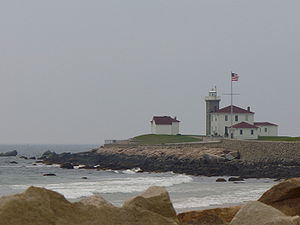
Watch Hill Lighthouse
Encyclopedia

French and Indian War
The French and Indian War is the common American name for the war between Great Britain and France in North America from 1754 to 1763. In 1756, the war erupted into the world-wide conflict known as the Seven Years' War and thus came to be regarded as the North American theater of that war...
and Revolutionary War. Destroyed in a 1781 storm, plans were discussed to build a new lighthouse to mark the eastern entrance to Fishers Island Sound and to warn mariners of a dangerous reef southwest of Watch Hill. President Thomas Jefferson
Thomas Jefferson
Thomas Jefferson was the principal author of the United States Declaration of Independence and the Statute of Virginia for Religious Freedom , the third President of the United States and founder of the University of Virginia...
signed an act to build the lighthouse in 1806 and construction was completed in 1807. The first lighthouse stood 35 feet (10.7 m) tall.
In 1827 a rotating light was installed to differentiate the light from that of the Stonington Harbor Light
Stonington Harbor Light
The Stonington Harbor Light is a historic nineteenth century lighthouse located on the east side of Stonington Harbor in Stonington, Connecticut. A light housed in a small granite lighthouse known by this name was originally built by the federal government in 1824, and was located on Windmill...
in Connecticut
Connecticut
Connecticut is a state in the New England region of the northeastern United States. It is bordered by Rhode Island to the east, Massachusetts to the north, and the state of New York to the west and the south .Connecticut is named for the Connecticut River, the major U.S. river that approximately...
. Erosion forced the lighthouse to close in 1855 and move further away from the bluff edge.
The next lighthouse, opened in 1856, stands 45 feet (13.7 m) tall. Sixteen years later the steamer Metis crashed off Watch Hill in 1872 killing 130 people. A United States Life-Saving Service
United States Life-Saving Service
The United States Life-Saving Service was a United States government agency that grew out of private and local humanitarian efforts to save the lives of shipwrecked mariners and passengers...
station was built next to the lighthouse where it operated until the 1940s and was destroyed in 1963. In 1873 Captain Jared Starr Crandall, keeper of the lighthouse, was awarded the Congressional Gold Medal for rescue operations involving the Metis. In 1879, Capt. Crandall's widow, Sally Ann (Gavitt) Crandall, became the first woman lighthouse keeper there.
In 1907, the steamer Larchmont collided with a schooner
Schooner
A schooner is a type of sailing vessel characterized by the use of fore-and-aft sails on two or more masts with the forward mast being no taller than the rear masts....
killing 200 people four miles from the lighthouse. The Hurricane of 1938 caused severe damage to the lighthouse. The Leif Viking ran aground a few hundred feet from the lighthouse in 1962, and although there were no injuries, the ship was stranded for nine days. The lighthouse was automated in 1986 and leased to the Watch Hill Lightkeepers Association.

